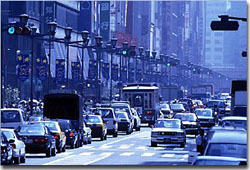Traffic Control System
Effective signal controls
For subsidiary roads (Recall control)
A control system in which the signal on the main road is always set to green, and the signal on the subsidiary road is turned green only when a vehicle or pedestrian is detected on the subsidiary road.
At intersections where the traffic volume on the subsidiary road is relatively low, the green signal is effectively controlled.
For right turns (Right-turn-actuated signal control)
Right-turns at intersections can be processed efficiently by lengthening right-turn arrow signal displays as soon as vehicle detectors detect vehicles in the intersection right-turn lanes.
For buses (Bus priority control)
Lengthening of green signal display and shortening of red signal display at intersections when bus detectors or infrared beacons register the approach of buses reduces the time buses have to wait at signals.
This priority signal control helps ensure that buses run on time.
For driver dilemma (Dilemma zone avoidance control)
The amber signal display helps drivers decide whether to stop or continue as they approach intersections, thus helping to reduce rear-end and head-on collisions.
For the elderly and others (Elderly-actuated signal control)

